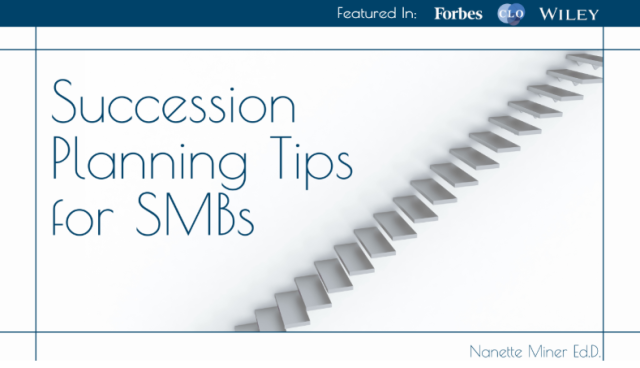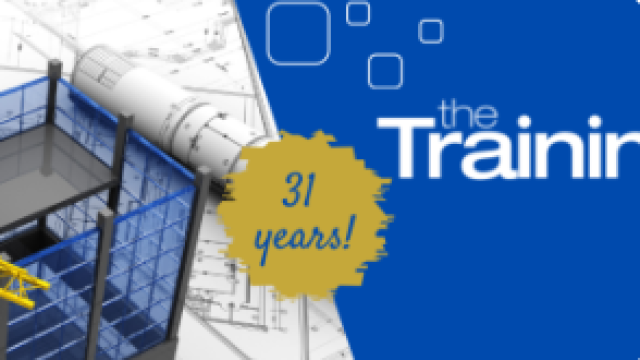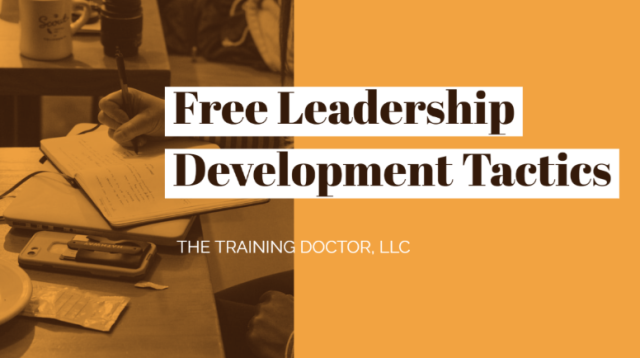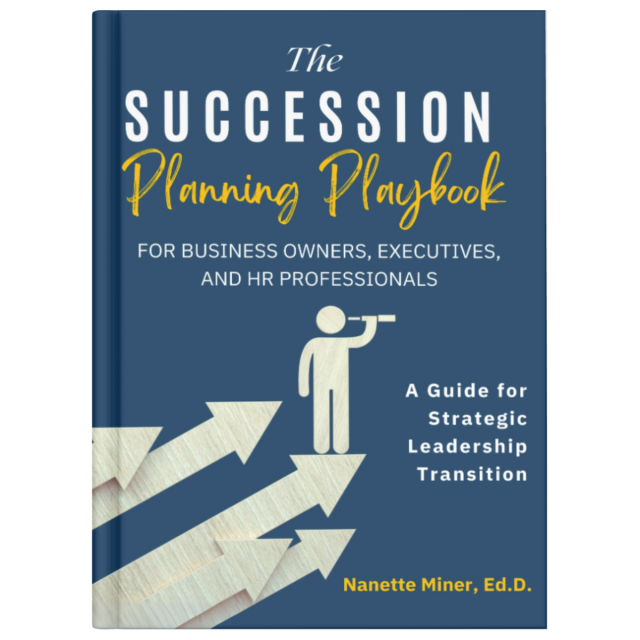

Succession advisor. Leadership development strategizer. Author. Vistage speaker. SCORE Mentor
Available For: Advising, Authoring, Consulting, Speaking
Travels From: Myrtle Beach, SC
Speaking Topics: Succession planning, organic leadership development
| Nanette Miner, Ed.D. | Points |
|---|---|
| Academic | 0 |
| Author | 29 |
| Influencer | 63 |
| Speaker | 0 |
| Entrepreneur | 30 |
| Total | 122 |
Points based upon Thinkers360 patent-pending algorithm.
 No One Was Steering the Ship!
No One Was Steering the Ship!
Tags: HR, Leadership, Management
Tags: HR, Leadership, Management
Tags: Future of Work, HR, Leadership
Tags: HR, Leadership, Management
 Using Assessments for Professional Development
Using Assessments for Professional Development
Tags: Leadership
 7 Phrases Every Leader Should Have in Their Vocabulary
7 Phrases Every Leader Should Have in Their Vocabulary
Tags: Leadership
 Is There a Difference between Leadership "Training" and Leadership "Development?"
Is There a Difference between Leadership "Training" and Leadership "Development?"
Tags: Leadership
 A Year's Worth of Leadership Development Articles
A Year's Worth of Leadership Development Articles
Tags: HR, Leadership, Management
 One Critical Leadership Skill Anyone Can Learn – at any time
One Critical Leadership Skill Anyone Can Learn – at any time
Tags: HR, Leadership, Management
 3 Ways to Develop Leadership Skills in Your Employees - for FREE
3 Ways to Develop Leadership Skills in Your Employees - for FREE
Tags: Cybersecurity
 Will Your Company Be Turning Out the Lights in 10 Years?
Will Your Company Be Turning Out the Lights in 10 Years?
Tags: HR, Leadership, Management
 Can One Employee Take Your Company Down?
Can One Employee Take Your Company Down?
Tags: HR, Leadership, Management
 Succession Planning Playbook
Succession Planning Playbook
Tags: Entrepreneurship, HR, Leadership
Tags: Construction, HR, Leadership
Tags: Entrepreneurship, HR, Leadership
 How to Vet and Choose the Right Coach for a Leader
How to Vet and Choose the Right Coach for a Leader
Selecting the right executive coach can be one of the most powerful investments you make in your leaders—and your organization. The right match accelerates growth, sharpens decision-making, and strengthens the leadership pipeline. But the process requires more than a quick Google search. Here are the steps to vetting and choosing an appropriate coach for your leader or up-and-coming leader.
Start with Trusted Sources
Begin your search in the right places. Ask HR peers which coaches delivered real results for their leaders. Referrals often uncover exceptional talent not found online. You can also explore credible directories such as the International Coaching Federation (ICF), EMCC Global, or the Institute of Coaching.
Clarify the Purpose
Before reaching out to potential coaches, define what success looks like. Is the goal leadership development, team alignment, or behavioral change? A clear purpose guides the selection and ensures measurable outcomes.
Match the Coaching Model to Your Needs
Not all coaches work the same way. Some follow a structured methodology; others take a more consultative or hybrid approach. Evaluate how each model aligns with your culture, budget, and expectations.
Vet Credentials and Chemistry
Use a structured checklist: relevant leadership experience, a proven process, flexibility, and a strong record of results. Equally important is chemistry—coaching is deeply personal. Allow the leader to meet two or three finalists and choose the coach they feel most comfortable with.
Define the Engagement
Once selected, formalize the partnership. Outline goals, timelines, reporting structures, and confidentiality boundaries. Schedule check-ins to assess progress and adjust as needed.
Measure Success
Effective coaching produces visible improvements—greater confidence, clearer communication, and stronger alignment with company strategy. When done well, coaching doesn’t just develop a single leader; it strengthens the organization’s entire leadership bench.
= = =
We’ve just released How to Vet & Choose the Right Coach for Your Leader.
Download your FREE copy here.
Tags: Entrepreneurship, HR, Leadership
 There Seems to be Some Confusion: Exit vs Succession
There Seems to be Some Confusion: Exit vs Succession
A few months ago, a legal journal approached me about writing an article for their publication on the difference between an exit plan and a succession plan. It seems that even your attorney doesn’t know.
Business owners often use the terms "exit planning" and "succession planning" interchangeably, but these concepts, while related, have distinct focuses and purposes. Understanding the differences between the two is crucial to ensure the longevity of your business and preserve your legacy. Or sell for an incredible valuation – whatever floats your boat.
Exit planning addresses how and when you will transition out of the company. The main objectives of exit planning include:
Exit planning involves a number of professionals you are undoubtedly already working with: financial planners/CPAs, an attorney, and perhaps a change or strategy consultant.
Succession Planning is the process of identifying and developing new leaders who can replace today’s leaders when they leave, retire, or unexpectedly pass away. I don't mean to be Debbie Downer, but according to the Wall Street Journal, 19 CEOs of Fortune 500 companies died while in office in 2023. Yipes!
The primary goals of succession planning include:
One thing that both the exit plan and the succession plan have in common is that they start YEARS before you plan to actually leave the business – allowing sufficient time for preparation on all fronts (my ideal timeline for succession planning is 18 months to 3 years, but that depends on the quality of internal candidates you have today).
Exit planning and succession planning are both critical for small businesses; you shouldn’t confuse them or ignore either one.
Ready to get going on your succession plan? Download our 12-month Succession Planning Calendar here.
Tags: Entrepreneurship, HR, Leadership
 In Order to Develop Your Future Leaders — You Need to Let Go
In Order to Develop Your Future Leaders — You Need to Let Go
There’s a pivotal moment in every senior leader’s journey when the focus must shift from doing to developing. For many senior executives, especially those who’ve built their organizations from the ground up, this can feel like handing over the keys to your classic car to a pre-teen who can't reach the pedals.
But here’s the bottom line: if you want to build a leadership pipeline that lasts — one that outlives you and your good work — you must learn to let go.
Stop Being the Decider
Most companies unintentionally stunt leadership development because decisions are made at the top — always. Employees bring questions, managers wait for approvals, and everything funnels up to one or two people who “know best.”
If you’re serious about developing your next generation of leaders, that has to change.
Start by encouraging up-and-coming leaders to make independent decisions. Let them analyze the situation, make a call, and then debrief afterward. When someone takes ownership of a decision — even a small one — they begin to build confidence, judgment, and accountability. Those are the muscles leaders need to develop before they’re handed real authority.
Move from Decision Maker to Coach
It’s easy to stay in the driver’s seat because it’s faster and safer. But leadership development isn’t about efficiency — it’s about long-term competency.
Your role must evolve from primary decision-maker to coach. Instead of telling people what to do, ask open-ended questions* like:
Coaching requires patience, but it creates independent thinkers — the kind who can lead without you standing over their shoulder. Offer feedback, share your reasoning, and provide support when the stakes are high. Over time, you’ll notice that your team starts coming to you not for answers, but for validation that they’re on the right track.
Make Feedback a Habit
Feedback isn’t a once-a-year performance review — it’s a continuous dialogue. Regular check-ins, short debriefs after projects, and strategic one-on-one discussions are the places where real learning happens.
These conversations serve two purposes:
Constructive feedback isn’t criticism; it’s coaching in action. The more often you provide it, the more normalized it becomes — and the faster people grow.
Gradually Step Back
Letting go requires a gradual process of reducing your involvement while staying available for guidance.
Think of it like teaching a teenager to drive. You start in an empty parking lot. Then neighborhood streets. Then the highway. Eventually, they drive alone — but they still know they can call you if they hit a snag.
In business, the same applies. Assign increasingly complex projects, broaden their responsibilities, and let them make decisions that once landed on your desk. Be there when things go wrong (and they will), but resist the urge to swoop in and fix things. Each stumble is part of the learning curve.
But Wait! There’s More: Reinforce Culture and Values
Technical competence is only half the equation. Your future leaders must also embody the culture and values that define your company.
Talk openly about what those values look like in daily decisions. Share examples of when they’ve been tested — and upheld. When leaders act in ways consistent with your company’s core beliefs, it builds credibility, loyalty, and alignment throughout the organization.
Culture isn’t taught through manuals; it’s absorbed through example. The more you model and articulate it, the more naturally your successors will carry it forward.
Letting Go Is the Ultimate Test of Leadership
It’s ironic, isn’t it? The final stage of great leadership is about stepping back, not stepping up. Letting go can feel risky — even uncomfortable — but it’s the only way to ensure that the company, and the people within it, will continue to thrive long after you’re gone.
Start small. Give others room to decide, to act, and to learn. Provide feedback, correction, and context — then let them take it from there.
At the end of the day, the measure of your leadership isn’t how many decisions you made, but how many decision-makers you created.
*Note: An open-ended question, also known as a high-gain question, is one that cannot be answered with a yes or no. The question’s style requires the respondent to share their thinking, feeling, or rationale. This helps you to understand their viewpoint and correct it, or ask another open-ended question to help them refine/expand their thinking, such as: Assume the contingency fund is already used, then what?
Tags: Entrepreneurship, HR, Leadership
 Is Your Company Saleable - from a People Standpoint?
Is Your Company Saleable - from a People Standpoint?
Often times a business owner is ready to leave their business, by selling it or retiring, and they face the rude awakening that the company isn't ready!
A lot of elements go into exiting your business. Not just ownership or financials.
Will the company be able to run without you? Or, if you step away, does the company in all practicality cease to exist?
This is exactly the situation that Jeff and Spencer Jan, the brothers who created the Solo Stove, faced. When their company had reached $7M they decided they would sell it. They consulted an advisor to start the process and were told: You don't have anything to sell. The brothers were shocked. What do you mean? It's a $7M business! BUT YOU ARE THE BUSINESS, replied the advisor. You do all the logistics, all the manufacturing, all the customer service, all the finance... when you walk away, there is no business anymore.
Does this story sound even slightly similar to your situation?
If you intend to pass the torch to a younger generation – familial or not - have you prepared them to run the company?
Even if you intend to sell, as the Jan brothers did, the company needs to be self-sufficient and on a continued path of success for it to be enticing to buyers.
So here are three tips (from the people domain) to ensure your company is ready for succession:
I hope you just shouted Whew! We’re good! But if you didn’t… drop me a note, here, to strategize.
Tags: Entrepreneurship, HR, Leadership
 Why I Hate Hi-Pos
Why I Hate Hi-Pos
I’ve worked in leadership development for decades—and I’ll say it plainly: I hate “hi-po” programs.
For the uninitiated, “hi-po” stands for high potential. The classic definition is an individual with the ability, ambition, and organizational commitment to succeed in senior-level roles beyond their current performance. These are the people organizations label as their “future leaders.”
Over the years, I’ve consulted for several companies that proudly ran high-potential programs. Typically, they recruit standout college graduates and put them into intensive three- or four-year rotational programs. Participants are taught leadership skills while being cycled through departments to gain a broad understanding of the business. On paper, it sounds impressive.
BUT I just don’t buy into the thinking behind these programs.
Selecting a handful of bright college students and declaring them “the future” is like putting all your eggs in one very untested basket. You’re investing time, money, and attention into individuals who haven’t proven themselves in the real world.
And let’s be honest—college achievement has little to do with workplace success. GPA doesn’t measure resilience, emotional intelligence, or the ability to lead under pressure.
The Tom Brady Test
Let’s look at a sports analogy.
Tom Brady was the 199th draft pick in 2000. He wasn’t chosen until the sixth round.
He joined the New England Patriots as the fourth quarterback. No team needs four quarterbacks—what was he going to do there?
Now contrast that with Johnny Manziel. A Heisman Trophy winner in his freshman year! Nicknamed “Johnny Football,” he was a first round draft pick in 2014. Talk about high potential!
Manziel barely made it through his first year. He flamed out spectacularly. Meanwhile, Brady went on to become one of the greatest leaders—and players—in NFL history.
Why the difference?
Because technical ability and leadership ability aren’t the same thing. What someone does in college doesn’t necessarily translate into real-world performance.
Tom Brady wasn’t the most remarkable athlete, but he grew into an extraordinary leader. Johnny Manziel had all the talent in the world - but lacked the ability to lead a team.
The Lesson for Business
We make the same mistake in organizations every day—confusing someone who is good at their job with leadership potential. Instead of betting on a few “future leaders,” why not invest in everyone’s development?
What harm could come from making every employee a better communicator, collaborator, or problem solver? None. In fact, your entire organization becomes stronger.
When you give everyone the opportunity to learn and grow, those who want to lead will rise naturally—and you’ll have a deeper, more capable bench as a result.
Don’t pick and choose who gets development. Offer development opportunities to everyone. Teach them skills that you expect your leaders to possess (but won’t be mad at everyone having!). Expose them to the whole organization. “Test them” with stretch assignments.
A future leader doesn’t always look like “high potential” on day one.
Tags: Business Strategy, HR, Leadership
 Succession Planning Starts With Data
Succession Planning Starts With Data
Most executives agree that succession planning is essential. Yet typically, its progress is based on gut feelings instead of facts. Starting with data is critical. Numbers tell you not only where you stand today, but also how well prepared your company is for tomorrow.
Here are the critical data points every organization should collect and analyze before building a succession strategy.
Mission-Critical Roles and Readiness
Begin by taking inventory of your mission-critical positions. How many exist in your organization? More importantly, how many of them do not have at least one ready successor identified? This data alone reveals your company’s vulnerability.
Once critical roles are identified, assess your talent pipeline in three timeframes:
This breakdown provides a snapshot of organizational bench strength and helps you forecast where leadership gaps may appear, so you can be prepared rather than reactive.
The Size and Health of Your Succession Pool
The succession pool is only as strong as the number of candidates within it. Tracking the size of the pool—and the turnover rates of its members—can highlight whether you are truly developing a pipeline or just relying on a handful of names.
Key measures include:
Development and Assessment Metrics
Succession planning is about risk management and business continuity. Just as your insurance broker will estimate the impacts your company may endure during a covered event, you must estimate the impacts and ripple effects of losing a key employee and not having a capable and ready replacement to step in to the void. To estimate your risks and impacts, consider:
The Role of Outsiders
An often-overlooked data point is how much outside talent you bring in. Promoting from within strengthens culture and rewards loyalty, but “outsiders” are critical for fresh ideas and perspectives. A good rule of thumb: aim for about 20% of senior leaders to come from outside the company. These hires should be carefully vetted—both for their ability to challenge the status quo and their fit with your company’s values and competencies. (Your internal culture and high-performing leadership team should make being chosen from outside the company a coveted victory.)
Turning Numbers into Strategy
Collecting the data is only the first step. The real power comes from asking: What story do these numbers tell?
Why It Matters
Succession planning without data is guesswork. With data, you can identify blind spots, strengthen weak points, and create a leadership pipeline that ensures business continuity. Think of this process as your insurance policy against disruption. The more accurate your data, the better able you are to create a strategy and the more confident you can be that the right people will be in the right roles—today, tomorrow, and years into the future.
NM
Tags: Entrepreneurship, HR, Leadership
 Centralized or Decentralized Succession Planning?
Centralized or Decentralized Succession Planning?
One of the important strategic decisions you'll have to make when determining how to approach your succession planning is whether you want the execution of it to be centralized or decentralized.
Centralized
If you choose the centralized route, HR will be the hub of the succession planning. They will know who is in the pipeline, they will oversee or even prescribe the professional development that those people will need in order to be prepared, they will sign people up for classes, send them to conferences, hire them coaches, and make sure that they are progressing along a career path and/or a learning path.
Decentralized
In the decentralized approach, all of those responsibilities just listed will be taken on by every department head, whatever title you want to give that (manager, director, VP, etc.). In the decentralized approach each individual department will plan their own succession pipeline and keep HR in the loop. HR will not have individual sightlines into each department’s or each individual’s succession plan. Instead, HR will be kept apprised of the plan and act as a consultant to the department head.
The role of HR is very different in the centralized versus decentralized approach. In the decentralized approach HR is more of an advisor to each individual department, as opposed to owning the process and making sure that the company, as a whole, has succession planning in place.
Example
If a department head says “I want my folks to have more industry knowledge,” HR would say, “OK, give me a week and I'll come back with a couple of options that might fit your goals.” What HR won't do is assess where people stand now, what development they need, or be involved in the development process in any way other than an advisory role.
HR’s Responsibility
The responsibility that HR has when the process is decentralized is that HR has to make sure that all department heads know what they're doing.
The centralized versus decentralized decision depends on how your organization prefers to manage the process and how much time and dedication you think your individual department heads will give to the process. Also, consider if a department head leaves, will the next leader be on board with this responsibility?
Warning: There is one glaring problem when succession planning is decentralized, and that is: if a particular department just drops the ball. HR may not be apprised of the fact that there may be a big gap in the succession pipeline of a particular department. In the centralized scenario, HR will make sure that every spoke in your company hub has a succession plan in place, and people are progressing through that plan.
Tags: Entrepreneurship, HR, Leadership
Location: Myrtle Beach, SC Fees: 17,500.00
Service Type: Service Offered
 How Long Does a CEO Transition Take?
How Long Does a CEO Transition Take? No One Was Steering the Ship!
No One Was Steering the Ship! The Hidden Gap
The Hidden Gap How to Vet and Choose the Right Coach for a Leader
How to Vet and Choose the Right Coach for a Leader There Seems to be Some Confusion: Exit vs Succession
There Seems to be Some Confusion: Exit vs Succession  In Order to Develop Your Future Leaders — You Need to Let Go
In Order to Develop Your Future Leaders — You Need to Let Go